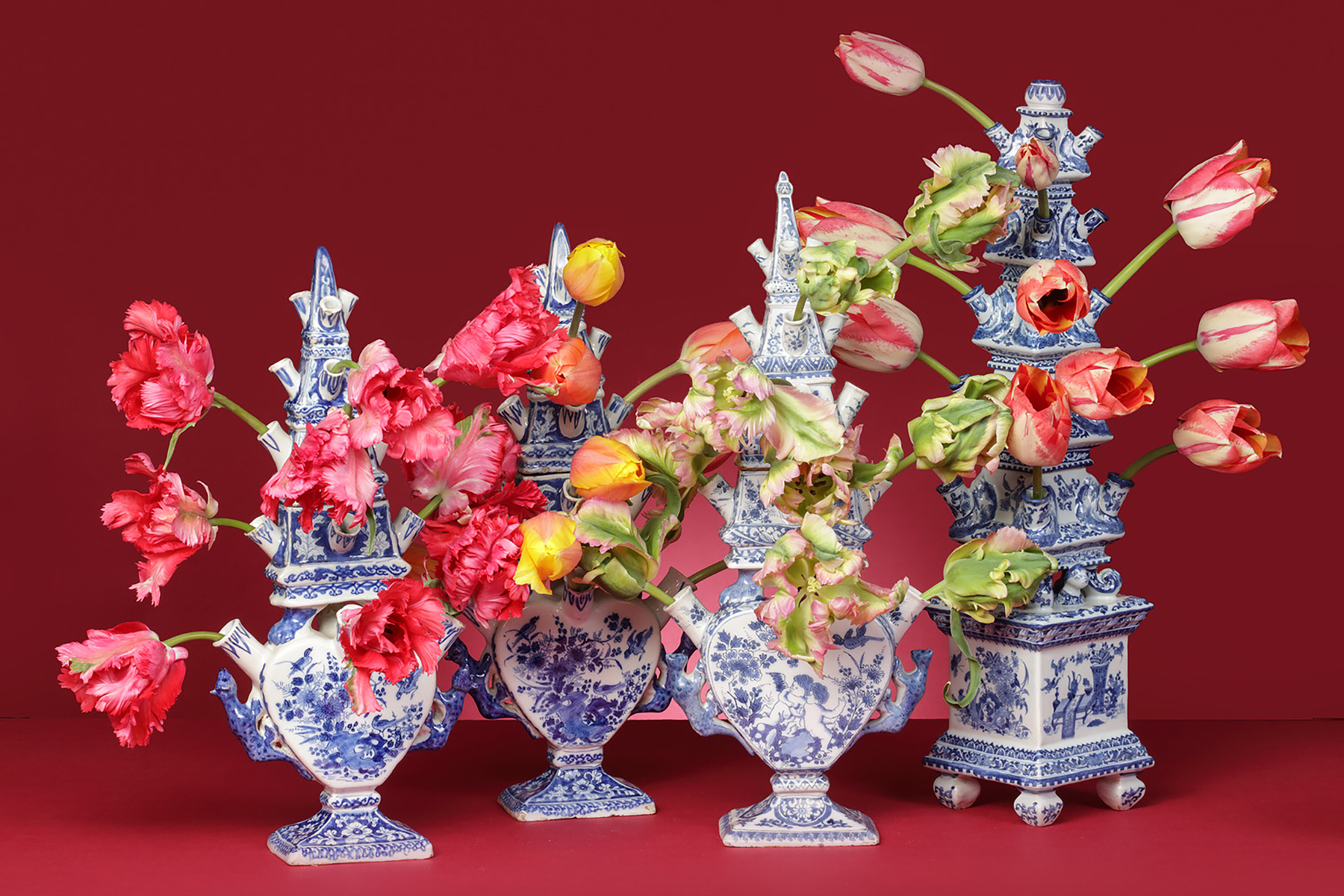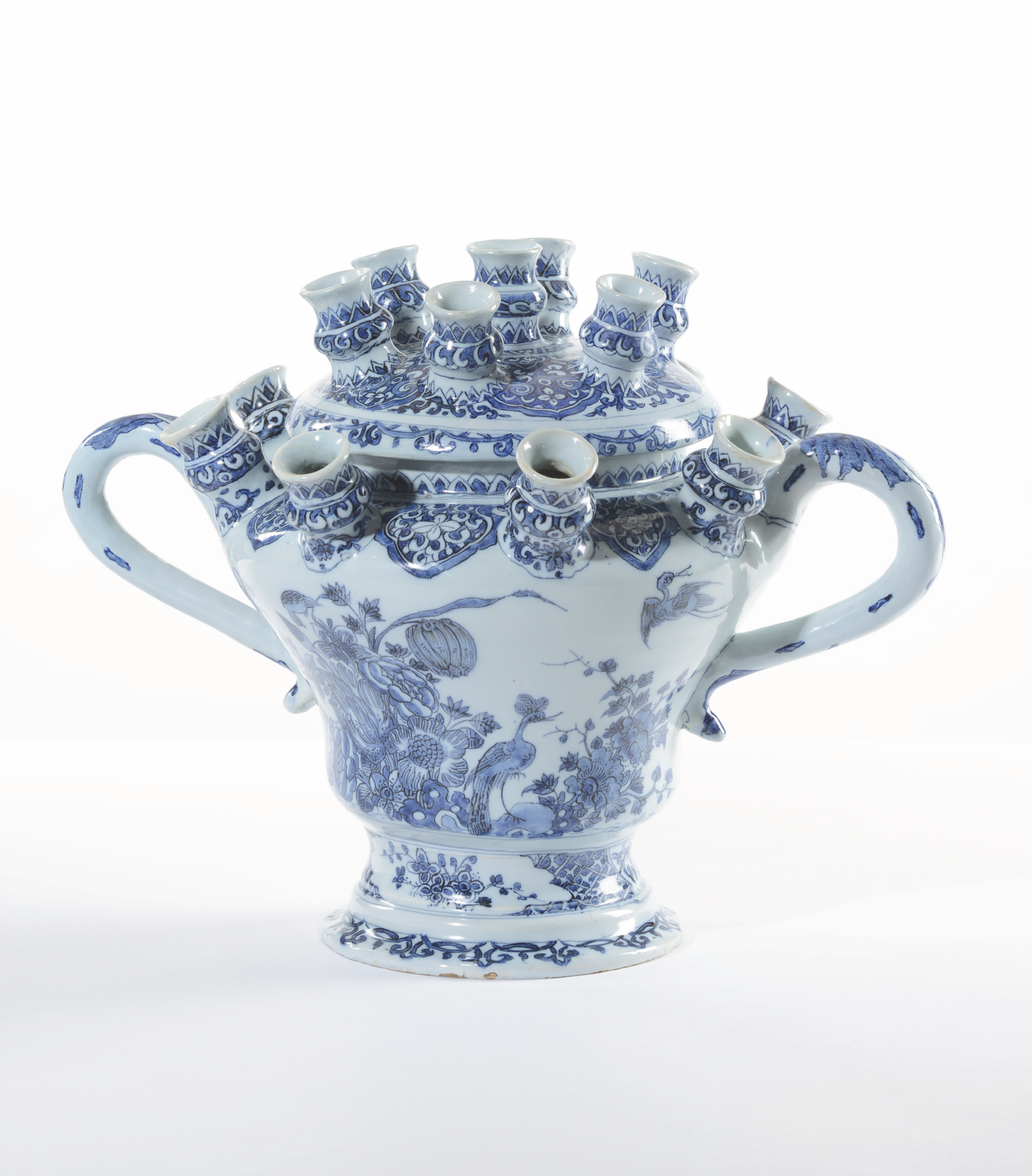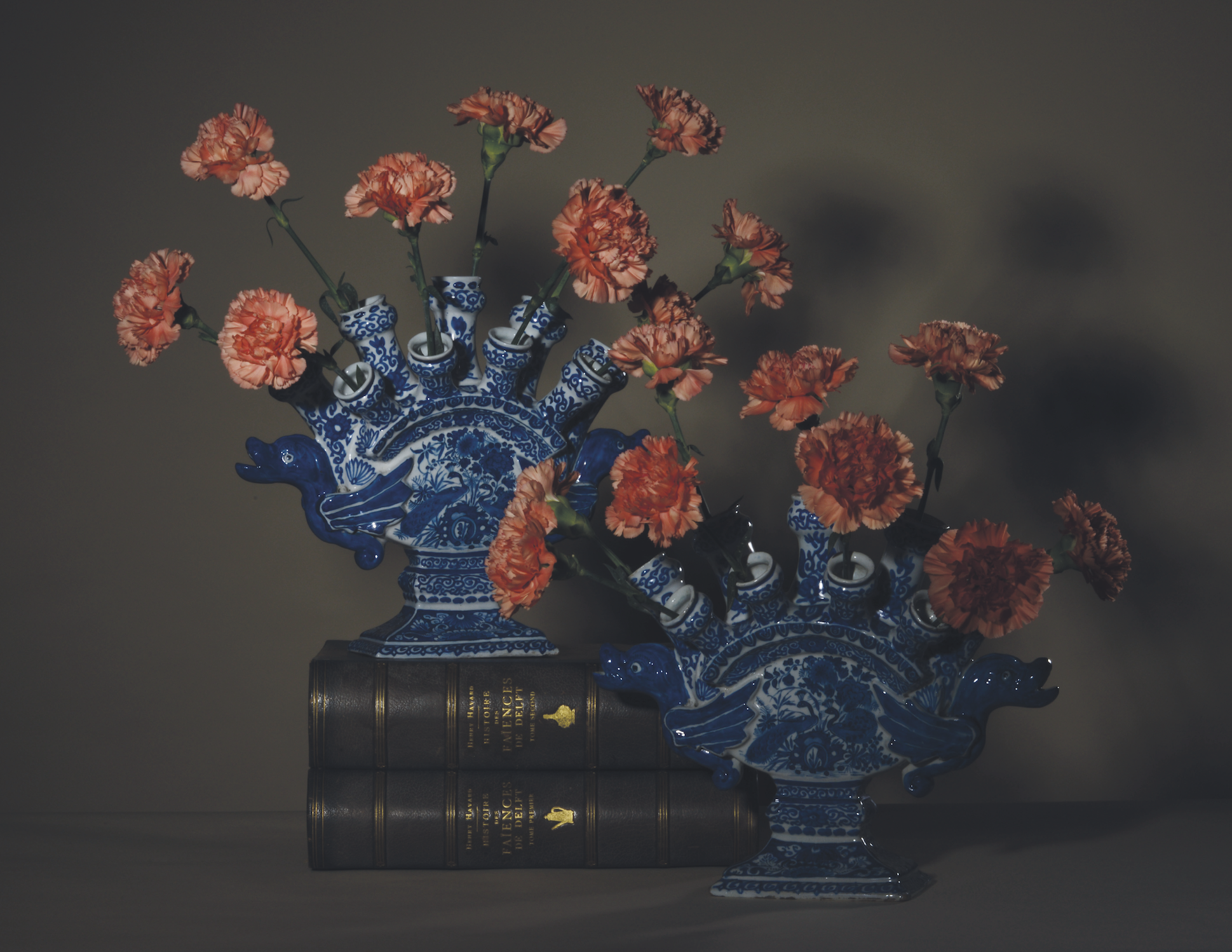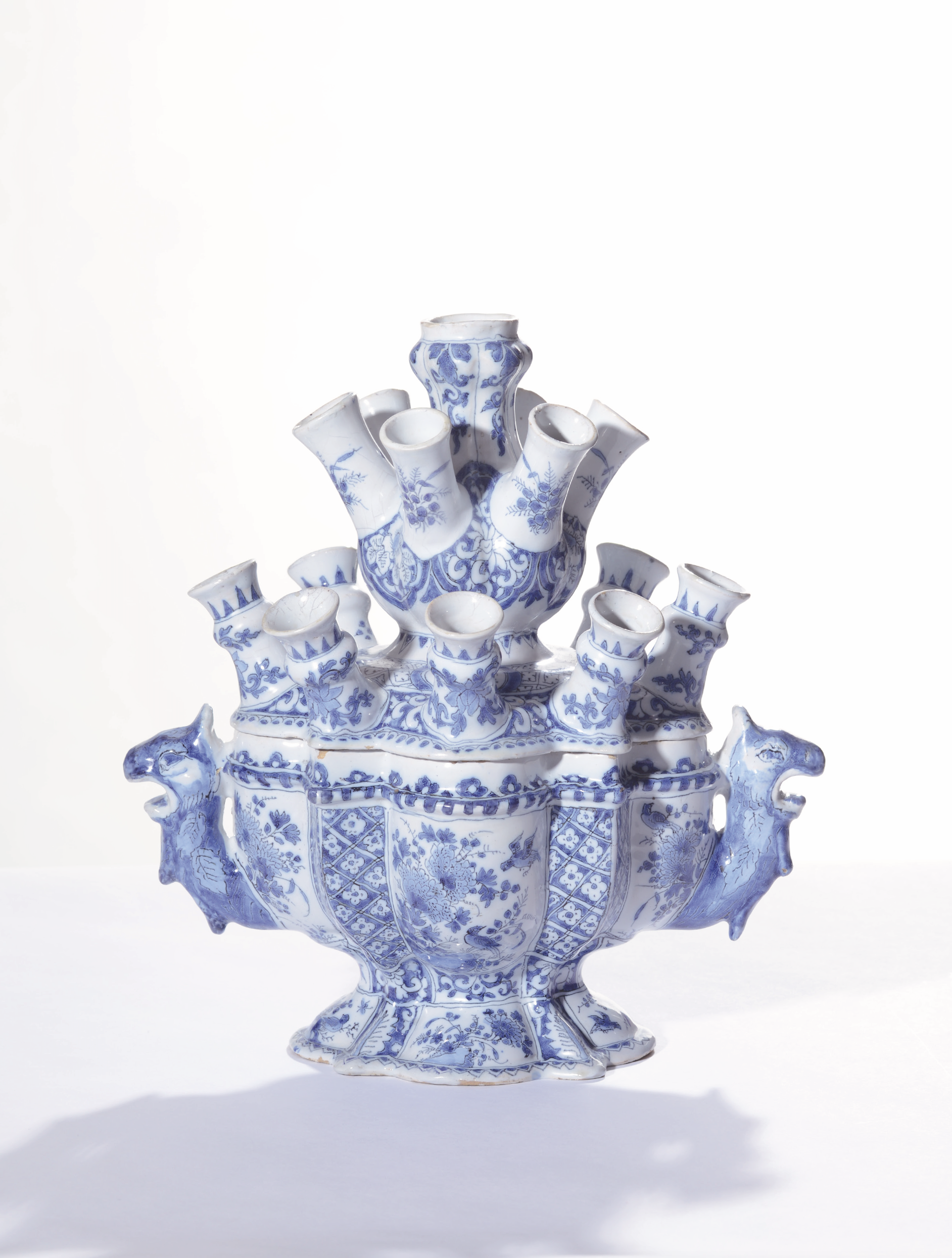
Delftware Flower Vases
In 1677, Mary Stuart (1662-1694), daughter of James, Duke of York and future James II, arrived in Holland after a treacherous journey from England. She was fifteen years old, and had just married her cousin, William III, stadholder of Holland. With her animated and personable demeanor, the Dutch people quickly developed an adoration for Queen Mary. Throughout her reign, she used her popularity and international influence to promote Dutch culture.
 Mary had several beloved pastimes that have come to characterize her cultural influence: gardening, Dutch Delftware and Chinese porcelain. In Asia, the Dutch East India Company (VOC) enjoyed a commercial monopoly and were thus primary importers of the region’s exotic and expensive goods. These products, which included spices, silk, porcelain and flower bulbs, were collected with great enthusiasm by the Dutch elite. Flowers and exotic plants were particularly coveted and the propagation of new varieties became a suitable pastime for ladies and gentlemen of rank.
Mary had several beloved pastimes that have come to characterize her cultural influence: gardening, Dutch Delftware and Chinese porcelain. In Asia, the Dutch East India Company (VOC) enjoyed a commercial monopoly and were thus primary importers of the region’s exotic and expensive goods. These products, which included spices, silk, porcelain and flower bulbs, were collected with great enthusiasm by the Dutch elite. Flowers and exotic plants were particularly coveted and the propagation of new varieties became a suitable pastime for ladies and gentlemen of rank.
Queen Mary’s fondness for flowers was also displayed in the elegant rooms of her royal palaces. The royal family patronized the great Dutch and Flemish botanical and floral artists, whose lush and colorful still life paintings decorated her rooms and became part of the royal art collection. The Queen also commissioned innovative Delftware vases to display her most precious garden species. Mary ordered a range of spouted vases. According to the inventories, these ‘portable gardens,’ as well as most of her ‘Delft porcelain’ were often displayed in rooms with direct access to the garden or in galleries.
 With Queen Mary as an influential tastemaker, vases with spouts became extremely popular and the range of designs widened. Around 1700, there were over thirty potteries in operation in Delft, of which at least five produced vases with holes and spouts, as their makers’ marks indicate. De Grieksche A (The Greek A) factory was perhaps the earliest producer of the vases, with modestly sized objects that date to 1680. Together with De Metaale Pot (The Metal Pot) factory, the two potteries created the largest output of flower vases over a period of sixty years. Other producers of outstanding flower vases were Het Jonge Moriaanshooft (The Young Moor’s Head), De Drie Posteleyne Astonne (The Three Porcelain Ash Barrels) and De Witte Ster (The White Star) factory.
With Queen Mary as an influential tastemaker, vases with spouts became extremely popular and the range of designs widened. Around 1700, there were over thirty potteries in operation in Delft, of which at least five produced vases with holes and spouts, as their makers’ marks indicate. De Grieksche A (The Greek A) factory was perhaps the earliest producer of the vases, with modestly sized objects that date to 1680. Together with De Metaale Pot (The Metal Pot) factory, the two potteries created the largest output of flower vases over a period of sixty years. Other producers of outstanding flower vases were Het Jonge Moriaanshooft (The Young Moor’s Head), De Drie Posteleyne Astonne (The Three Porcelain Ash Barrels) and De Witte Ster (The White Star) factory.
The manufacturing process for Delft flower holders, both large and small, was complex. The footed, closed body of the vases was affixed with spouts of different shapes and sizes and proved difficult to remove from the kiln. The multi-tiered vases were even more tenuous in the kiln, as the potters had to ensure that all the parts fit well after the firing. Many times, vases would collapse or break in the kiln. Based on the range of dimensions of surviving examples, Delftware factories probably used a number of different molds to achieve the flower vase designs. For angular and ribbed objects, the potters used plaster molds, in which the clay was pressed. Handles and spouts were also modeled in separate plaster molds. The resulting casts were individually secured to the object with a thin, watery clay known as slip. During the firing process distortions or irregularities could develop. There were usually small differences in size as unpredictable shrinkage occurred during the process of cooling in the kiln.
 Although the vases in the seventeenth and eighteenth centuries were filled with all varieties of cut flowers, there has been much misunderstanding about this. In the mid- nineteenth century, when collectors and art historians rediscovered Delftware, they must have thought that the vases were intended to be filled with hyacinth bulbs or flowers, as they came to be known as ‘bouquetiers à Jacinthes’. Not long thereafter, however, a more familiar name came into fashion, which is still used today: ‘tulip vase’ or ‘tulipière,’ ascribed to these vases on the revised supposition that they were intended specifically to hold the precious and popular tulips.
Although the vases in the seventeenth and eighteenth centuries were filled with all varieties of cut flowers, there has been much misunderstanding about this. In the mid- nineteenth century, when collectors and art historians rediscovered Delftware, they must have thought that the vases were intended to be filled with hyacinth bulbs or flowers, as they came to be known as ‘bouquetiers à Jacinthes’. Not long thereafter, however, a more familiar name came into fashion, which is still used today: ‘tulip vase’ or ‘tulipière,’ ascribed to these vases on the revised supposition that they were intended specifically to hold the precious and popular tulips.
Flower vases enjoyed a brief heyday from 1688 to 1710. Their disappearance was partly caused by the decline of the Delft industry in the face of greater competition from Meissen factories and other European potters. Perhaps more significantly, flower vases disappeared after the deaths of their royal patrons and the end of the baroque styles so closely associated with them. Moreover, their decline is also linked with the changing ideas of the relationship between art and nature, which manifests itself in garden art. The monumental vases were viewed with disdain because many people felt that they imposed excessively strict restraints on nature. Further, in the direct confrontation between the two, art dominated too much.



